一、前言
APU系统中CPU以串行执行代码的方式完成操作,软件方式很难做到精准计时,因此调用内部定时器硬件完成计时是更好的选择。本文以定时器中断方式控制LED周期性闪烁为例学习私有定时器的使用。同时学习如何将软件程序与硬件比特流文件一起固化到SD卡中,实现上电自动配置与启动自定义系统。
功能定义:通过定时器中断实现与MIO连接的单个LED每200ms变化依次电平,即点亮,200ms后熄灭,200ms后再次点亮,周期往复。
硬件平台:米联客Miz702N
软件工具:VIVADO 2017.4+SDK
二、硬件系统搭建
私有定时器属于APU内部专用硬件资源,无需在VIVADO中做出配置。由于需要将软硬件系统固化到SD卡中,选择与SD控制器连接的I/O。
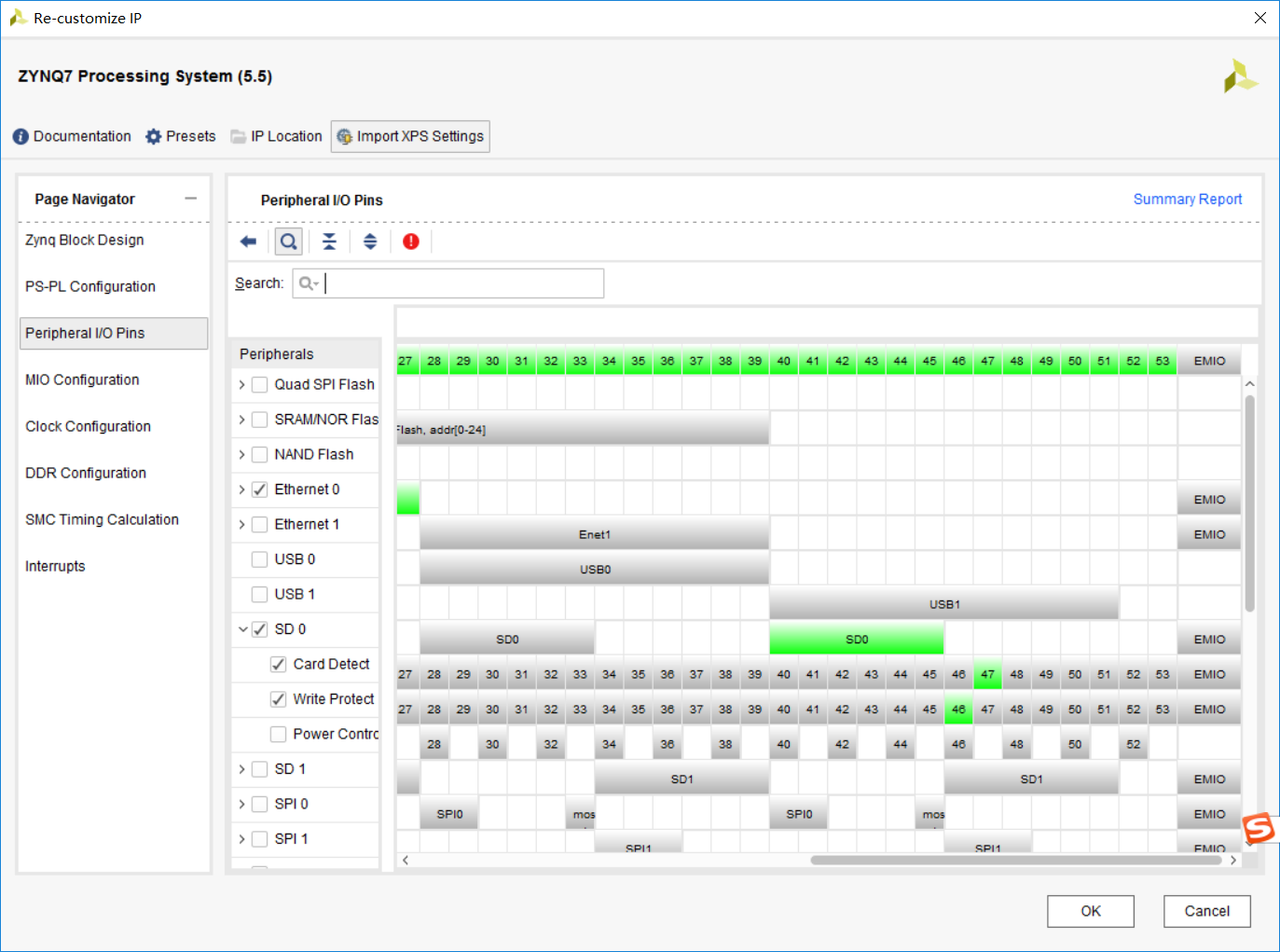
根据原理图,SD卡连接在MIO40~47,这也与UG585中的描述一致:

这里直接使用PWM产生呼吸灯效果工程中的硬件系统,可以更直观地观察出定时器控制LED与PWM控制LED互不影响。
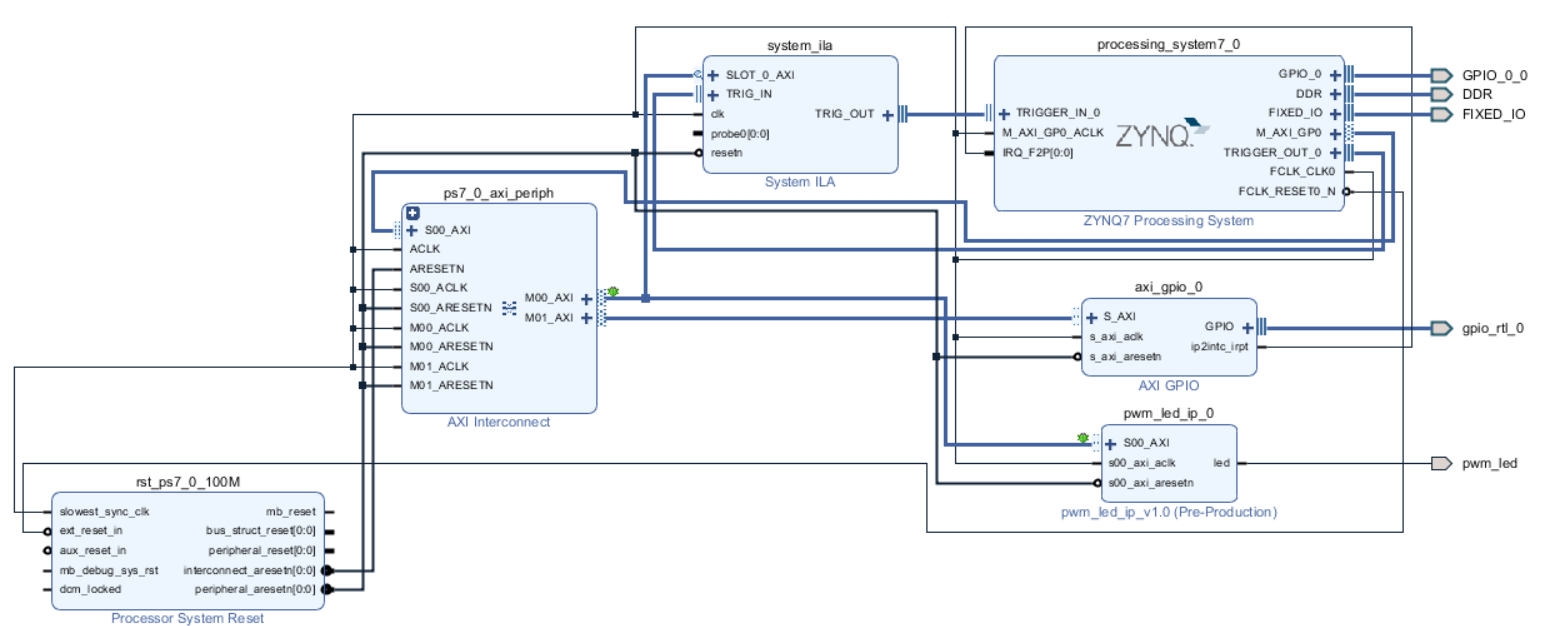
依然是重新产生输出文件、生成HDL Wrapper、RUN Synthesis、Run Implementation、Generate bitstream、export Hardware with bitfile、Launch SDK. 剩下的任务均在SDK中完成。
三、软件设计
关于私有定时器使用方式,xilinx同样提供了文档和示例程序。

软件代码中使用的定时器相关函数均来自示例程序。使用私有定时器第一步当然是初始化配置,老套路调用XScuTimer_LookupConfig和XScuTimer_CfgInitialize两个函数。为了保证LED周期性闪烁,必须使能定时器的自动重载,这样每当计数器计数完成后会重新计数。之后最重要的是向定时器装载寄存器写入计数周期数值。实际上私有定时器是一个递减计数器,当从最大值递减到0时刻会产生定时器中断。如和将所要定时的时间长度换算为装载计数器周期数值呢?
很简单,n=t/T=t*f即可算出装载数值,其中n、t和T分别指所要定时的时间和定时器工作时钟周期。因为定时器工作时钟频率一直是CPU工作时钟的一半,在本系统中即为333MHz。这个n=200*10^(-3)*333*10^6=666*10^5。计数器是N-1~0的计数方式,装载值在n的基础上减1,对应的十六进制数值是0x3F83C3F。
装载完毕后调用XScuTimer_Start定时器随即开始工作。最后在定时器中断回调函数中对MIO进行反转操作就可以满足功能预期。另外,对之前PWM实现呼吸灯效果的工程做些改善,软件程序如下:

1 /* 2 * main.c 3 * 4 * Created on: 2020年2月22日 5 * Author: s 6 */ 7 8 9 #include "environment.h" 10 11 12 13 int main() 14 { 15 int Status; 16 u8 i=0; 17 18 freq_step_value = 10; 19 20 Status = gpiops_initialize(&GpioPs,GPIOPS_DEVICE_ID); 21 if (Status != XST_SUCCESS) { 22 return XST_FAILURE; 23 } 24 25 Status = gpio_initialize(&Gpio,GPIO_DEVICE_ID); 26 if (Status != XST_SUCCESS) { 27 return XST_FAILURE; 28 } 29 30 Status = timer_initialize(&TimerInstance,TIMER_DEVICE_ID); 31 if (Status != XST_SUCCESS) { 32 return XST_FAILURE; 33 } 34 /* 35 * Set the direction for the pin to be output and 36 * Enable the Output enable for the LED Pin. 37 */ 38 gpiops_setOutput(&GpioPs,MIO_OUT_PIN_INDEX); 39 40 for(i=0;i<LOOP_NUM;i++){ 41 gpiops_setOutput(&GpioPs,EMIO_OUT_PIN_BASE_INDEX+i); 42 } 43 44 gpio_setDirect(&Gpio, 1,GPIO_CHANNEL1); 45 46 Status = setupIntSystem(&Intc,&Gpio,&TimerInstance, 47 INTC_GPIO_INTERRUPT_ID,TIMER_IRPT_INTR); 48 if (Status != XST_SUCCESS) { 49 return XST_FAILURE; 50 } 51 52 /* 53 * Enable Auto reload mode. 54 */ 55 XScuTimer_EnableAutoReload(&TimerInstance); 56 57 /* 58 * Load the timer counter register. 59 */ 60 XScuTimer_LoadTimer(&TimerInstance, TIMER_LOAD_VALUE); 61 62 /* 63 * Start the timer counter and then wait for it 64 * to timeout a number of times. 65 */ 66 XScuTimer_Start(&TimerInstance); 67 68 69 70 Status = pwm_led_setFreqStep(freq_step_value); 71 if (Status != XST_SUCCESS) { 72 return XST_FAILURE; 73 } 74 75 printf("Initialization finish. "); 76 77 while(1){ 78 79 for(i=0;i<LOOP_NUM;i++){ 80 if(int_flag == 0) 81 { 82 gpiops_outputValue(&GpioPs, EMIO_OUT_PIN_BASE_INDEX+i, 0x1); 83 usleep(200*1000); 84 gpiops_outputValue(&GpioPs, EMIO_OUT_PIN_BASE_INDEX+i, 0x0); 85 } 86 else 87 { 88 gpiops_outputValue(&GpioPs, EMIO_OUT_PIN_BASE_INDEX+LOOP_NUM-1-i, 0x1); 89 usleep(200*1000); 90 gpiops_outputValue(&GpioPs, EMIO_OUT_PIN_BASE_INDEX+LOOP_NUM-1-i, 0x0); 91 } 92 } 93 94 95 } 96 return 0; 97 } 98 99 100 101 int setupIntSystem(XScuGic *IntcInstancePtr,XGpio *gpioInstancePtr, 102 XScuTimer * TimerInstancePtr,u32 gpio_IntrId,u32 timer_IntrId) 103 { 104 int Result; 105 /* 106 * Initialize the interrupt controller driver so that it is ready to 107 * use. 108 */ 109 110 Result = gic_initialize(&Intc,INTC_DEVICE_ID); 111 if (Result != XST_SUCCESS) { 112 return XST_FAILURE; 113 } 114 115 XScuGic_SetPriorityTriggerType(IntcInstancePtr, gpio_IntrId, 116 0xA0, 0x3); 117 118 /* 119 * Connect the interrupt handler that will be called when an 120 * interrupt occurs for the device. 121 */ 122 Result = XScuGic_Connect(IntcInstancePtr, gpio_IntrId, 123 (Xil_ExceptionHandler)GpioHandler, gpioInstancePtr); 124 if (Result != XST_SUCCESS) { 125 return Result; 126 } 127 128 Result = XScuGic_Connect(IntcInstancePtr, timer_IntrId, 129 (Xil_ExceptionHandler)TimerIntrHandler, 130 (void *)TimerInstancePtr); 131 if (Result != XST_SUCCESS) { 132 return Result; 133 } 134 135 /* Enable the interrupt for the GPIO device.*/ 136 XScuGic_Enable(IntcInstancePtr, gpio_IntrId); 137 138 /* 139 * Enable the GPIO channel interrupts so that push button can be 140 * detected and enable interrupts for the GPIO device 141 */ 142 XGpio_InterruptEnable(gpioInstancePtr,GPIO_CHANNEL1); 143 XGpio_InterruptGlobalEnable(gpioInstancePtr); 144 145 /* 146 * Enable the interrupt for the device. 147 */ 148 XScuGic_Enable(IntcInstancePtr, timer_IntrId); 149 XScuTimer_EnableInterrupt(TimerInstancePtr); 150 151 /* 152 * Initialize the exception table and register the interrupt 153 * controller handler with the exception table 154 */ 155 exception_enable(&Intc); 156 157 IntrFlag = 0; 158 159 return XST_SUCCESS; 160 } 161 162 void GpioHandler(void *CallbackRef) 163 { 164 XGpio *GpioPtr = (XGpio *)CallbackRef; 165 u32 gpio_inputValue; 166 167 168 /* Clear the Interrupt */ 169 XGpio_InterruptClear(GpioPtr, GPIO_CHANNEL1); 170 printf("gpio interrupt. "); 171 172 //IntrFlag = 1; 173 gpio_inputValue = gpio_readValue(GpioPtr, 1); 174 switch(gpio_inputValue) 175 { 176 case 30: 177 //printf("button up "); 178 usleep(5); 179 gpio_inputValue = gpio_readValue(GpioPtr, 1); 180 if(gpio_inputValue == 30){ 181 freq_step_value = freq_step_value < FREQ_STEP_MAX ? 182 freq_step_value+10 : freq_step_value; 183 printf("%d ",freq_step_value); 184 pwm_led_setFreqStep(freq_step_value); 185 } 186 break; 187 case 29: 188 //printf("button center "); 189 usleep(5); 190 gpio_inputValue = gpio_readValue(GpioPtr, 1); 191 if(gpio_inputValue == 29){ 192 freq_step_value = FREQ_STEP_SET_VALUE; 193 pwm_led_setFreqStep(freq_step_value); 194 } 195 break; 196 case 27: 197 //printf("button left "); 198 usleep(5); 199 gpio_inputValue = gpio_readValue(GpioPtr, 1); 200 if(gpio_inputValue == 27) 201 int_flag = 0; 202 break; 203 case 23: 204 //printf("button right "); 205 usleep(5); 206 gpio_inputValue = gpio_readValue(GpioPtr, 1); 207 if(gpio_inputValue == 23) 208 int_flag = 1; 209 break; 210 case 15: 211 //print("button down "); 212 usleep(5); 213 gpio_inputValue = gpio_readValue(GpioPtr, 1); 214 if(gpio_inputValue == 15){ 215 freq_step_value = freq_step_value > FREQ_STEP_MIN ? 216 freq_step_value-10 : freq_step_value; 217 printf("%d ",freq_step_value); 218 pwm_led_setFreqStep(freq_step_value); 219 } 220 break; 221 } 222 223 } 224 225 void TimerIntrHandler(void *CallBackRef) 226 { 227 XScuTimer *TimerInstancePtr = (XScuTimer *) CallBackRef; 228 229 XScuTimer_ClearInterruptStatus(TimerInstancePtr); 230 231 gpiops_outputValue(&GpioPs, MIO_OUT_PIN_INDEX, sys_led_out); 232 sys_led_out = sys_led_out == 0x0 ? 0x1 : 0x0; 233 }

1 /* 2 * timer.h 3 * 4 * Created on: 2020年3月5日 5 * Author: s 6 */ 7 8 #ifndef SRC_TIMER_H_ 9 #define SRC_TIMER_H_ 10 11 #include "xscutimer.h" 12 13 #define TIMER_DEVICE_ID XPAR_XSCUTIMER_0_DEVICE_ID 14 #define TIMER_IRPT_INTR XPAR_SCUTIMER_INTR 15 16 //333*n(ms)*10^3-1 = 333*5*1000-1 = 1664999 0x1967E7 17 #define TIMER_LOAD_VALUE 0x3F83C3F 18 19 int timer_initialize(XScuTimer * TimerInstancePtr,u16 TimerDeviceId); 20 21 22 #endif /* SRC_TIMER_H_ */

1 /* 2 * timer.c 3 * 4 * Created on: 2020年3月5日 5 * Author: s 6 */ 7 8 9 #include "timer.h" 10 11 int timer_initialize(XScuTimer * TimerInstancePtr,u16 TimerDeviceId) 12 { 13 XScuTimer_Config *ConfigPtr; 14 /* 15 * Initialize the Scu Private Timer driver. 16 */ 17 ConfigPtr = XScuTimer_LookupConfig(TimerDeviceId); 18 19 /* 20 * This is where the virtual address would be used, this example 21 * uses physical address. 22 */ 23 return XScuTimer_CfgInitialize(TimerInstancePtr, ConfigPtr, 24 ConfigPtr->BaseAddr); 25 }
相比原来的程序,在GpioHandler中添加了对freq_step_value最值的限制以及按键消抖延时。
四、程序固化
本工程固化程序时要使用FAT文件系统,更改板级支持包设置,勾选xilffs库并重新生成BSP。
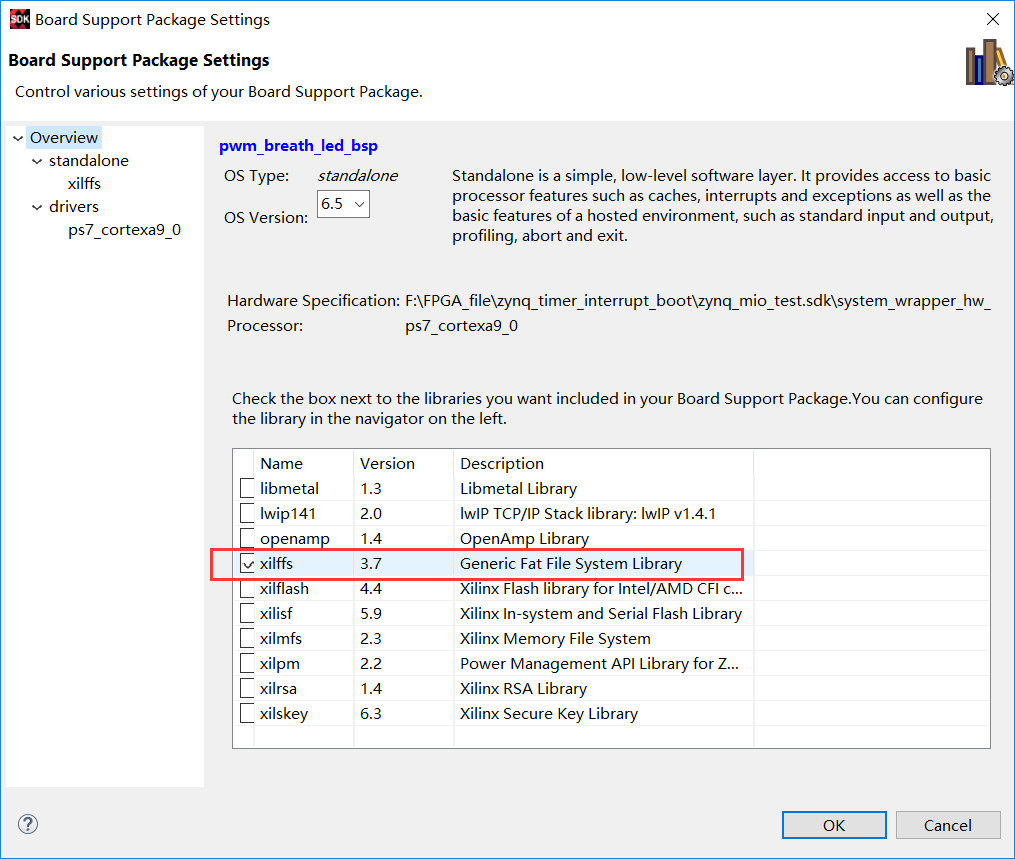
在固化程序之前,了解CPU的启动过程是非常必要的,这部分概念主要来自UG585文档。在上电复位后,硬件逻辑会根据启动模式引脚的高低电平选择启动方式。
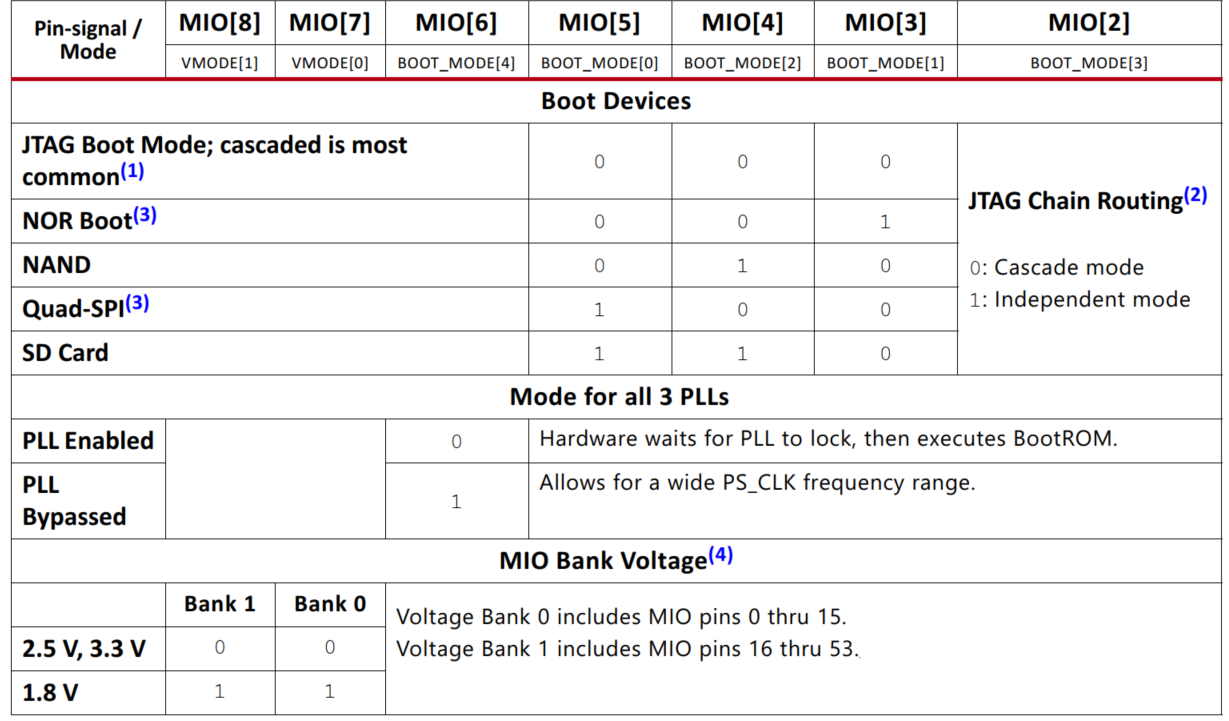
硬件一些初始化操作后执行CPU内部一个ROM中的代码来启动整个系统,这个ROM的名字叫BootROM。BootROM中的程序是第一个被CPU执行的代码,其主要任务是配置系统,并从boot device中拷贝系统镜像到OCM,配置DDR操作。
Boot device可以是Quad-SPI,NAND,NOR或者SD卡。Boot device中存储的是boot image,其由BootROM Header和FSBL以及User Code组成,当然也可包括用于配置PL的bitstream和软件OS。软件boot分为三个阶段:

其中FSBL起到组织作用,将PS部分软件生成的ELF文件和PL部分硬件bit文件组合在一起。该文件利用xilinx的FSBL示例工程生成,用户无需关注内部实现细节。
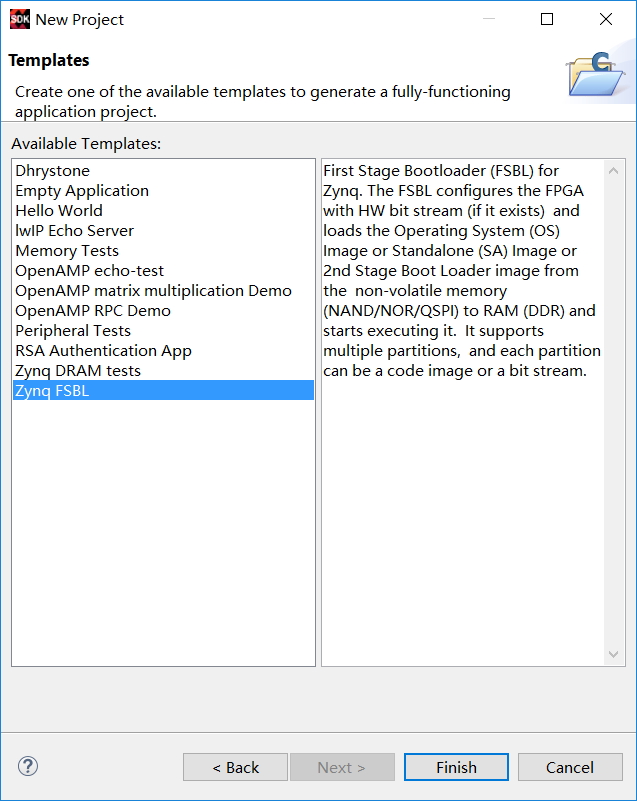
创建工程后会自动编译并生成ELF文件。点击工具栏xilinx -> create boot image。按照如下顺序添加三个文件:fsdb.elf --> bit --> <user_code>.elf
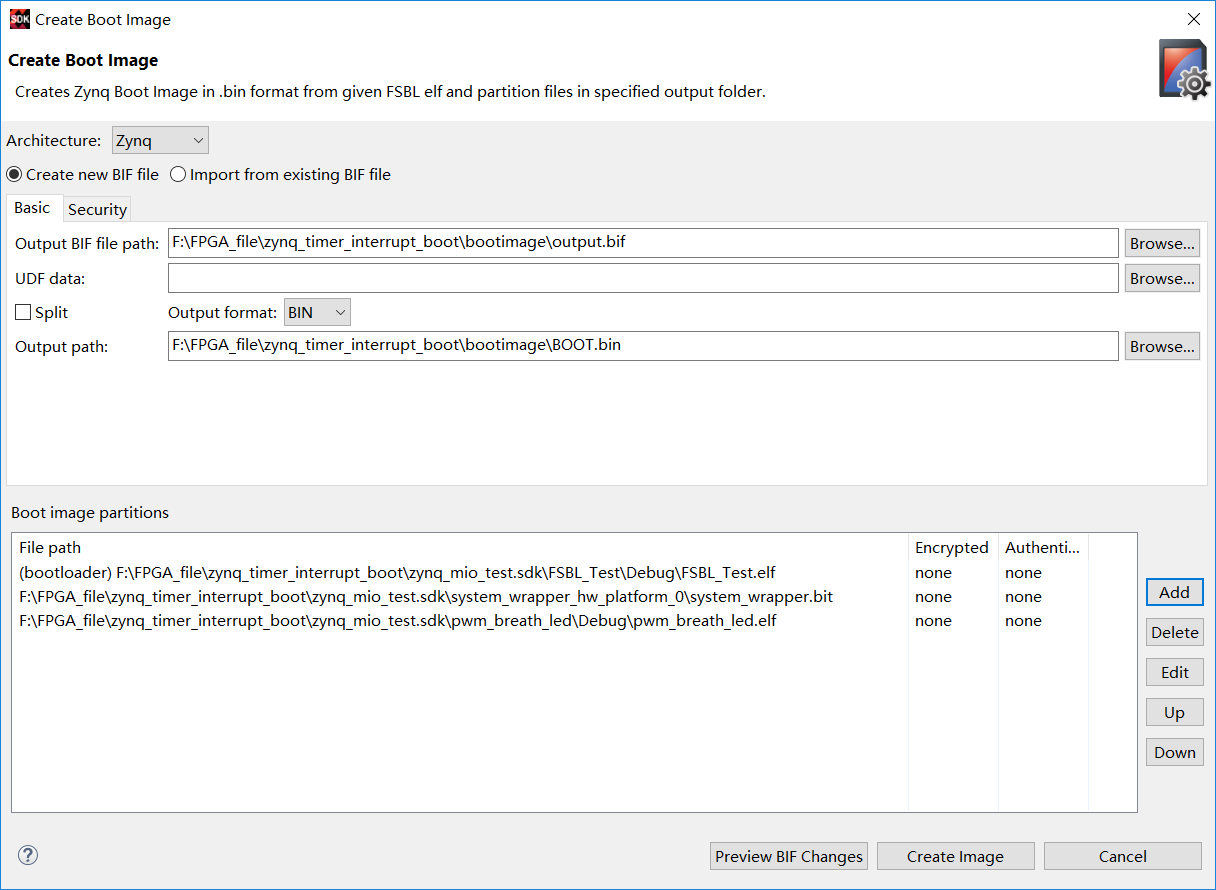
create image后会生成对应的bin文件,也就是之前阐述的启动镜像。

我们将BOOT.bin文件拷贝到空的SD卡中,利用拨码开关配置Boot Mode MIO Strapping Pins从SD卡启动。上电后等待一段时间MIO连接的LED灯周期性闪烁,PWM呼吸灯频率与流水灯方向根据按键变换,系统正常工作,完成了定时器中断应用和程序固化。
